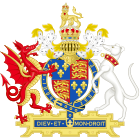First Succession Act facts for kids

|
|
| Citation | 25 Hen. 8. c. 22 |
|---|---|
| Territorial extent | Kingdom of England |
| Dates | |
| Royal assent | March 1534 |
| Repealed | June 1536 |
| Other legislation | |
| Repealed by | Succession to the Crown Act 1536 |
| Relates to | Succession to the Crown Act 1534 |
|
Status: Repealed
|
|
| Text of statute as originally enacted | |
The First Succession Act was a very important law passed in England in March 1534. It was signed by King Henry VIII and changed who would become the next ruler of England. This law is also known as the Succession to the Crown Act 1533. Even though it was passed in 1534, the legal calendar at the time started the year on March 25, so it was officially dated as 1533.
Contents
What Did the First Succession Act Do?
This law made a big change to the royal family's future. It decided that Elizabeth, who was the daughter of King Henry VIII and Anne Boleyn, would be the next in line to the throne. Elizabeth was born on September 7, 1533.
Why Was This Act Important?
Before this law, Mary, who was King Henry VIII's daughter with Catherine of Aragon, was expected to be the next queen. But the First Succession Act declared Mary to be illegitimate. This meant she was no longer seen as a rightful heir to the throne.
The Oath of Succession
The Act also said that everyone in England had to swear an oath. This oath made them promise to accept the new law and recognize King Henry VIII as the supreme head of the Church in England. If someone refused to take this oath, it was considered a very serious crime against the king, known as treason.
What Happened After This Act?
The First Succession Act was later changed by other laws.
- The Second Succession Act made Elizabeth illegitimate as well.
- The Third Succession Act later put both Mary and Elizabeth back in the line to become queen.

